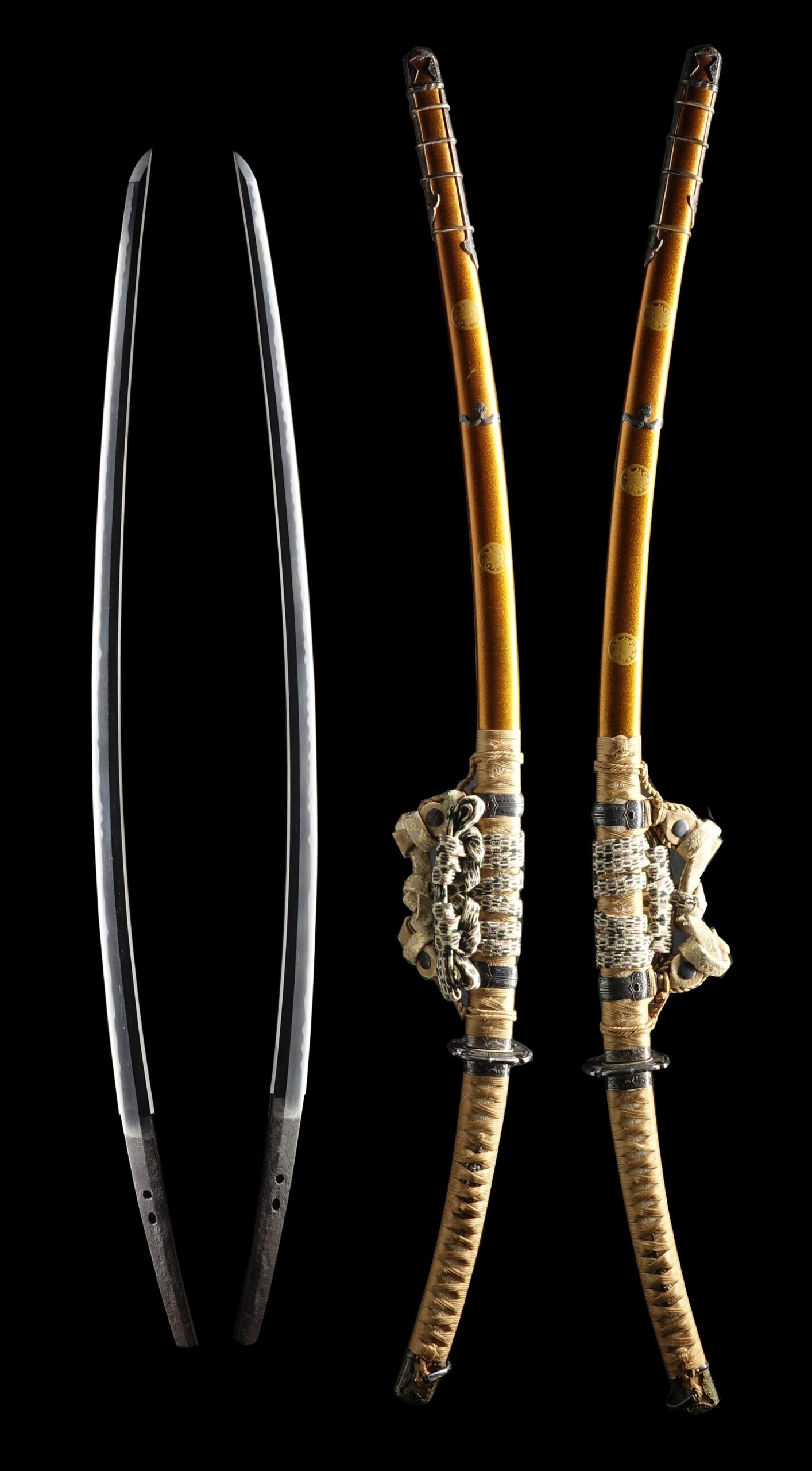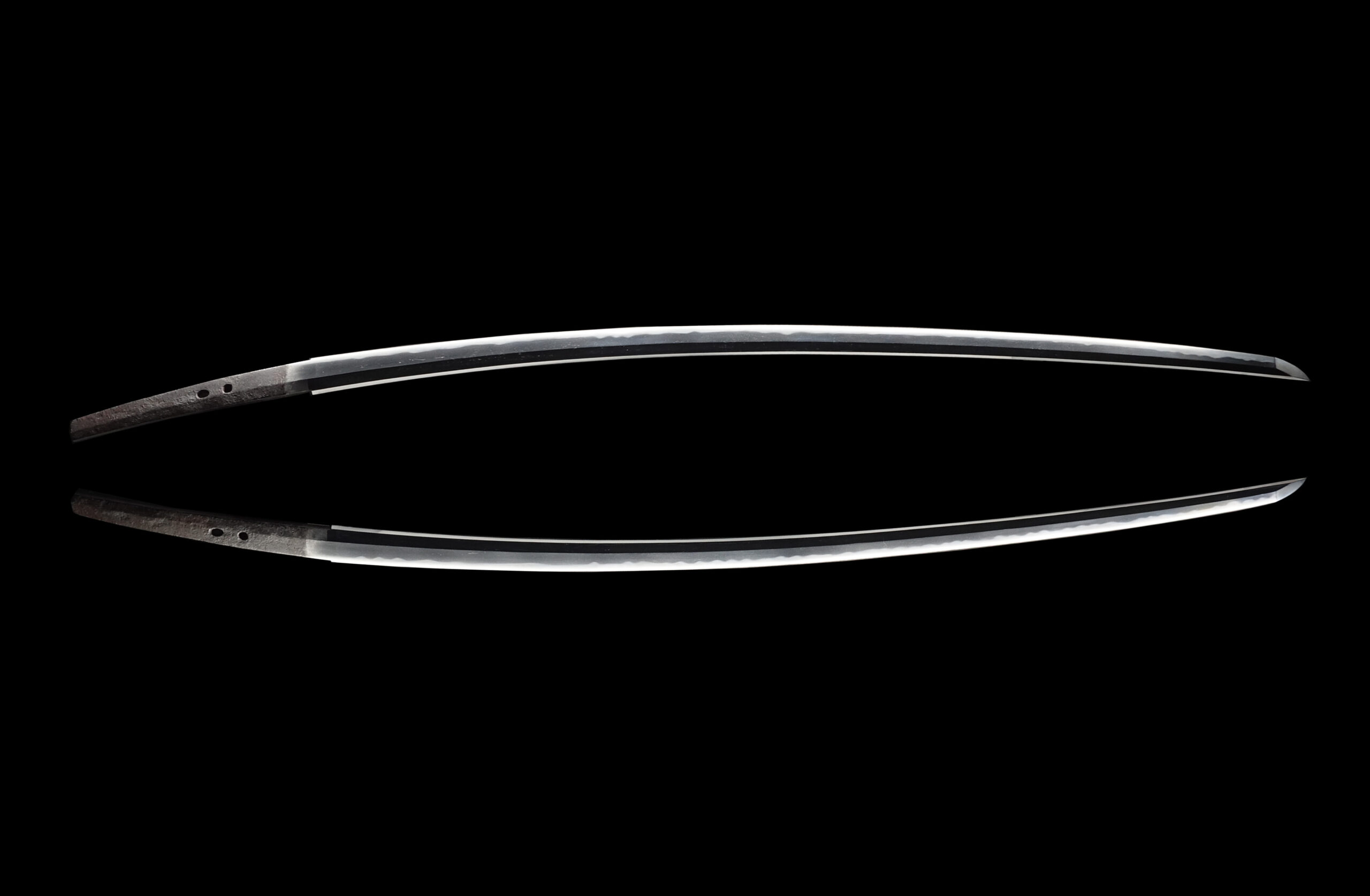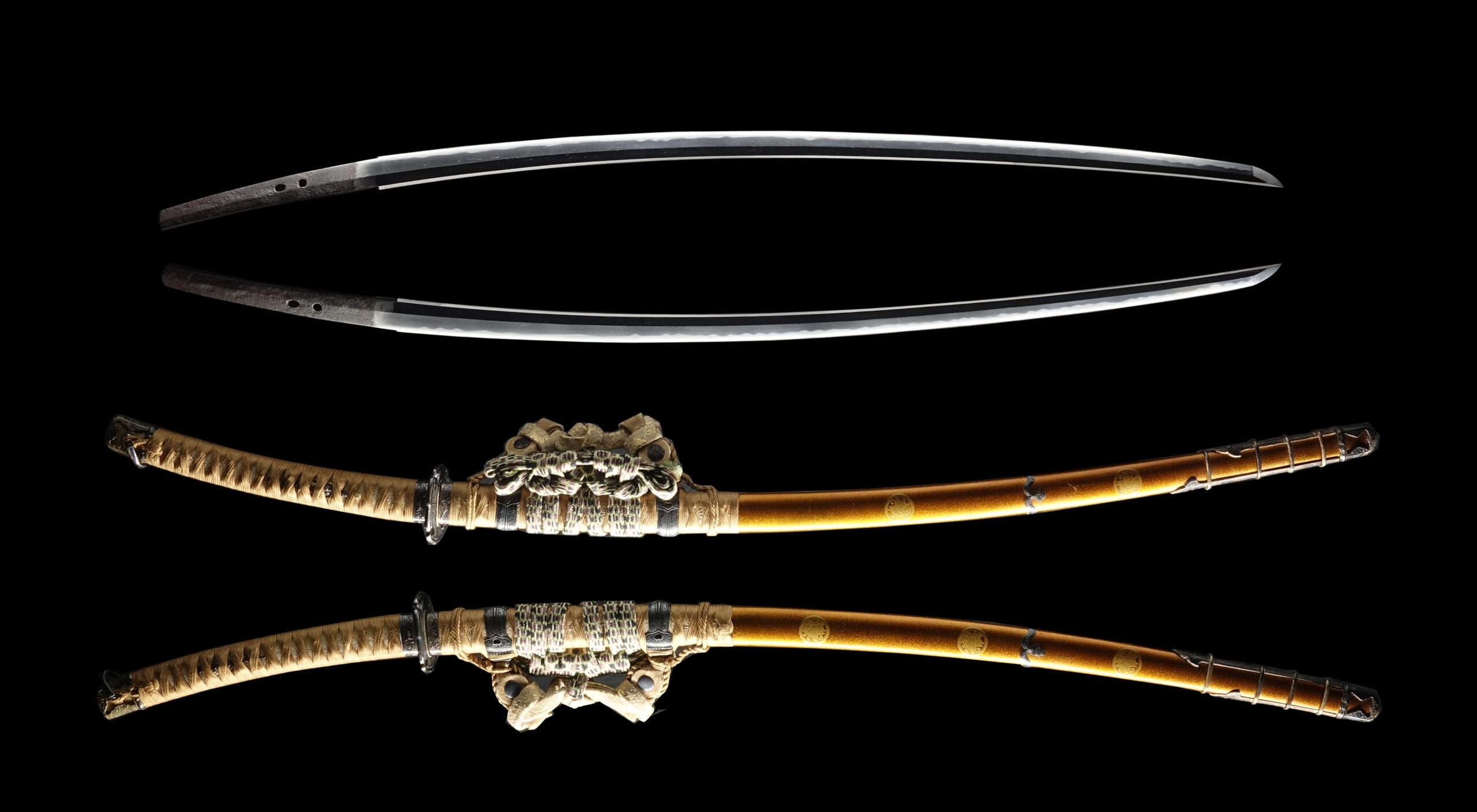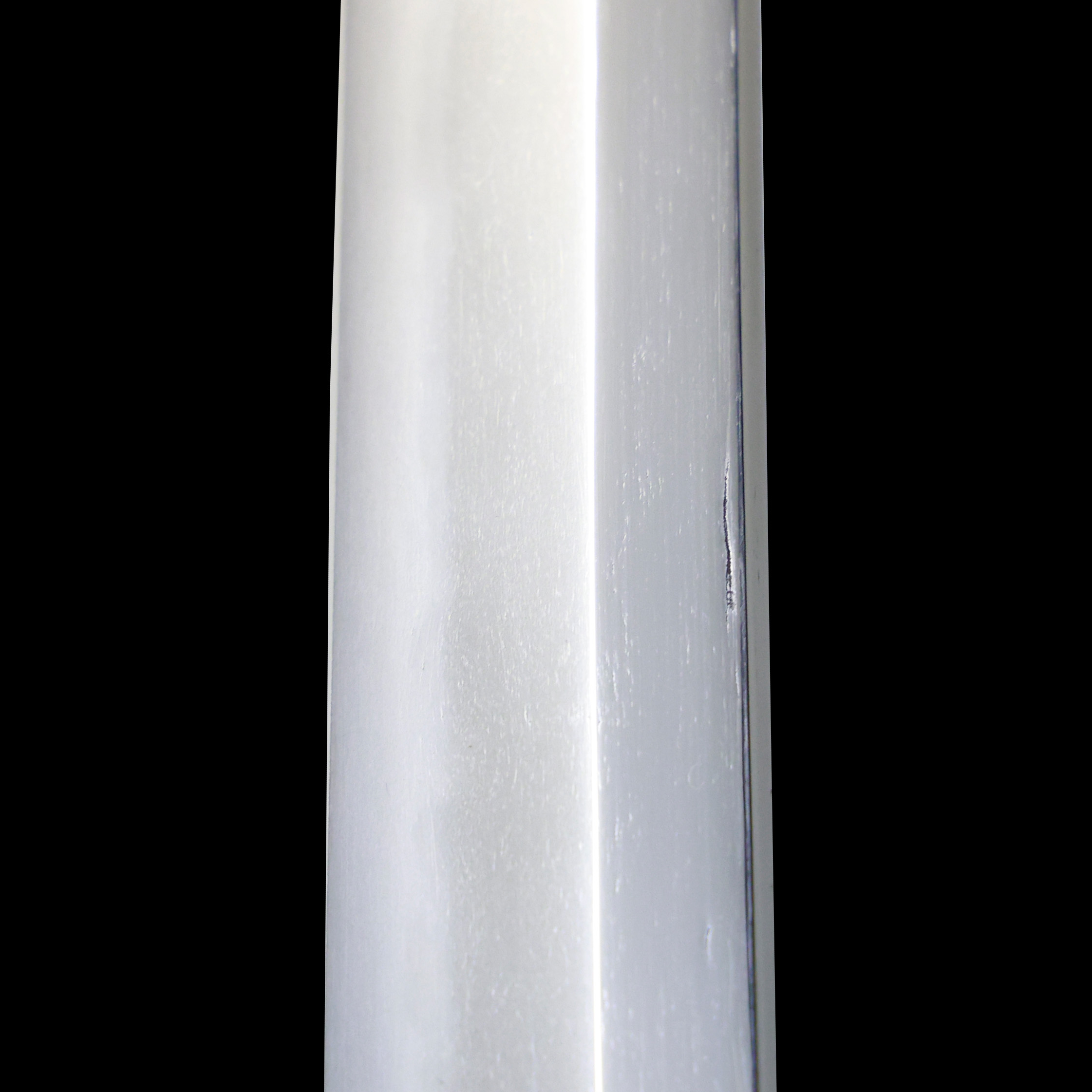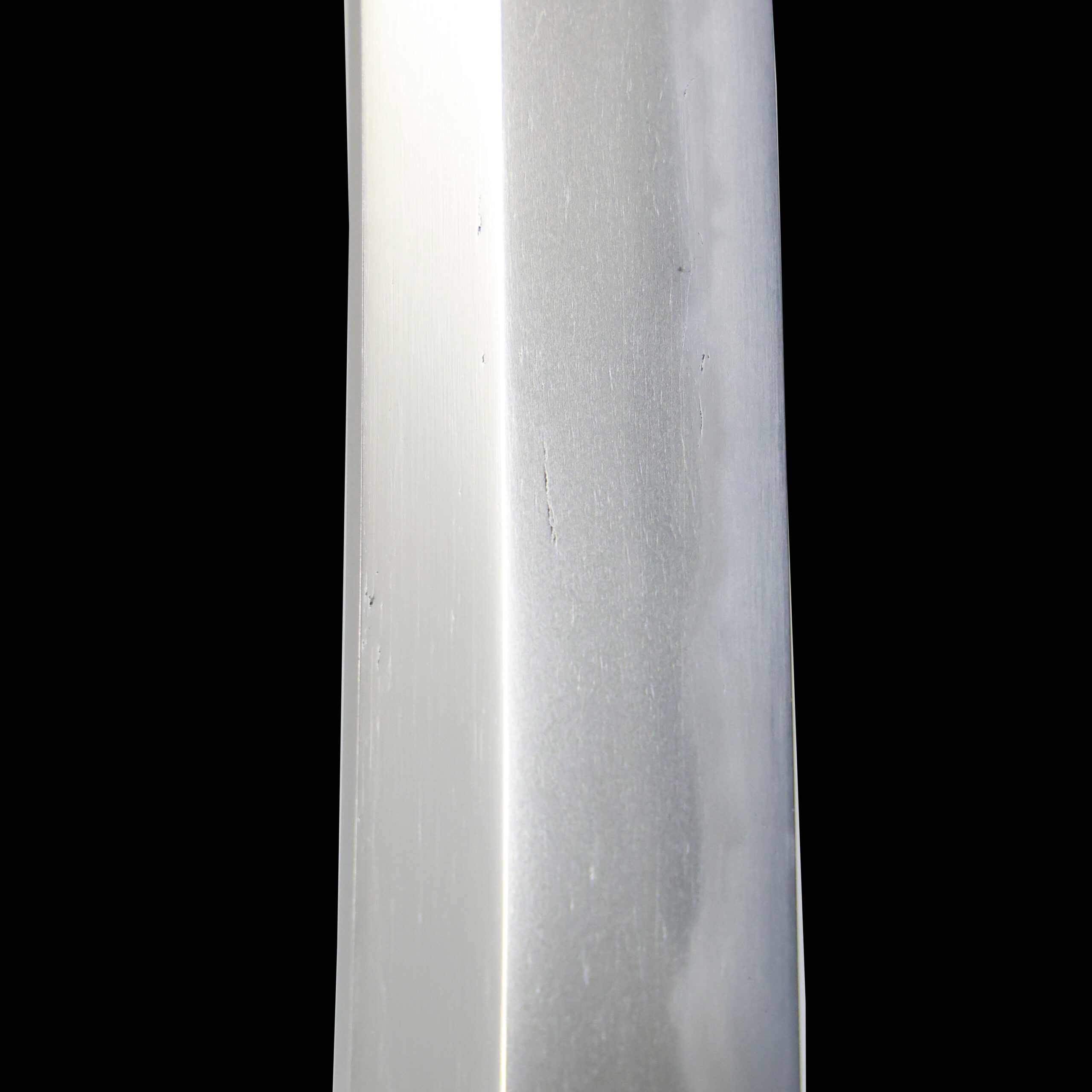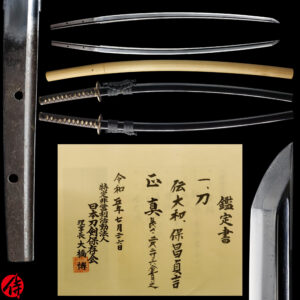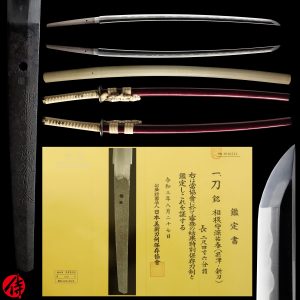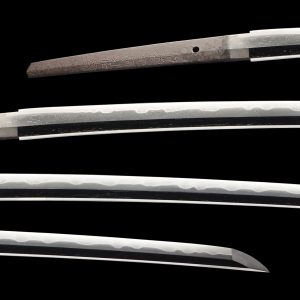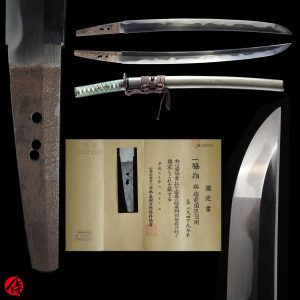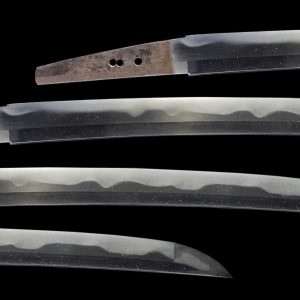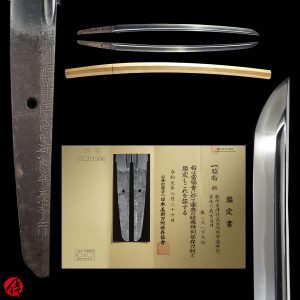Antique Japanese Sword Katana Attributed to Kashu Kagemitsu with Tokubetsu Hozon Certificate
【Description】
This blade is attributed to the work of Kashu Kagemitsu(加州景光). The smith’s name Kagemitsu lasted a few generations from the mid-Nanbokucho period-early Edo period (1356-1673). Based on the characteristic of this blade, we believe the attribution was given to one of Kagemitsu during the late Muromachi period (late 15th-early 16th century).
The first-gen Kashu Kagemitsu is said to have been an apprentice of Fujishima Tomoshige. Kagemitsu’s father was Masakage(正景), who had been active in sword-forging during the mid-late Nonbokucho period. This blade was created in the middle of Sengoku Jidai(warring state period: late 15th -late 16th century). During this time, there was so much rivalry among strong feudal lords over lands, political power, and natural resources. We believe Kagemitsu forged swords for those strong Samurais.
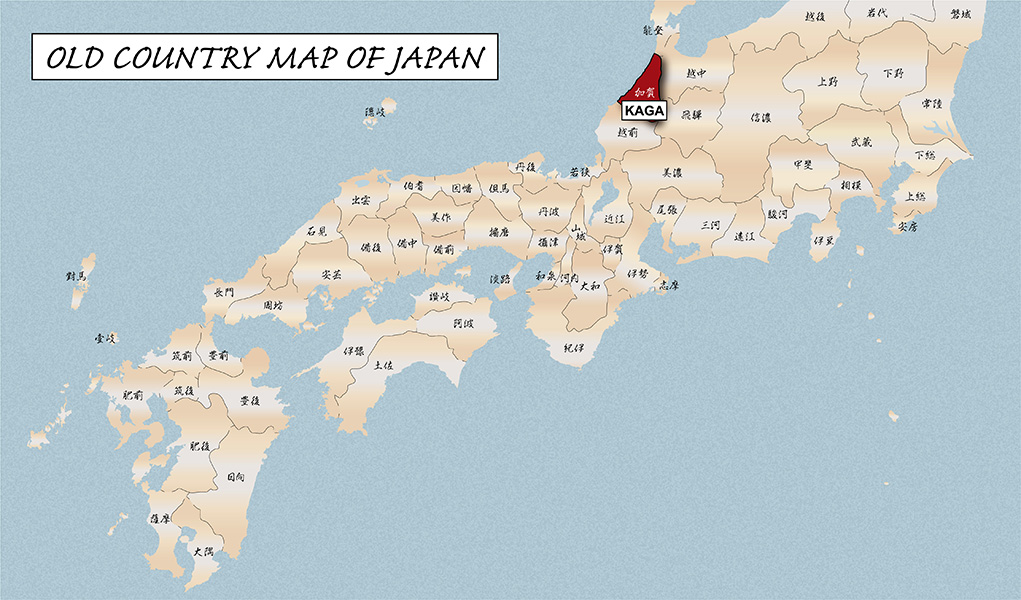
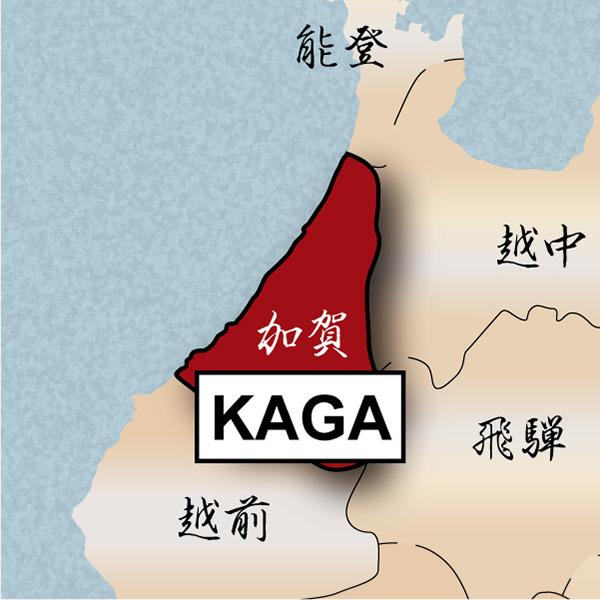
The generations of Kagemitsu were considered noble swordsmiths. It is said that Hojyo Ujiteru sent a sword forged by one of Kagekatsu to Date Masamune as a present. Both of them are famous warlords from the Sengoku period(warring state period). This story tells us how reputable Kagemitsu was as a swordsmith during that time.
Tachi and Tachi Koshirae
Based on the authentication paper, this blade was made as a Tachi (太刀). Its cutting edge is 84.4 cm with 3 cm curvature. And, it is stored in Tachi(太刀) Koshirae. Tachi was mainly used by an armored Samurai with one hand on horseback from the Heian period (794-1185 A.D.) until the early Muromachi period. TACHI was suspended loosely on the left waist with its edge facing the ground so that you could draw it faster to cut down soldiers on the ground. Because of its gorgeous looking, having a Tachi-style sword mounting became a social status among Samurai.
It is appraised as a Tokubetsu Hozon Token (特別保存刀剣) issued by NBTHK (Nihon Bijutsu Touken Hozon Kyokai:日本美術刀剣保存協会). This authentication paper was only given to authentic Japanese swords, especially well preserved and high quality with artistic value.
*Please keep in mind that there are a couple of noticeable Kitae Kizu on this blade. If you like to see the detailed condition, please feel free to contact us.
【Blade】
Cutting Edge Length(Nagasa):84.4 cm (33.2 inches)
Curvature(Sori):3.0 cm (1.18 inches)


Hamon:
The crystalline structure which forms along the cutting edge of a blade as a result of the hardening process
Jimon(Jihada):
visible steel surface pattern created by folding and hammering during forging process

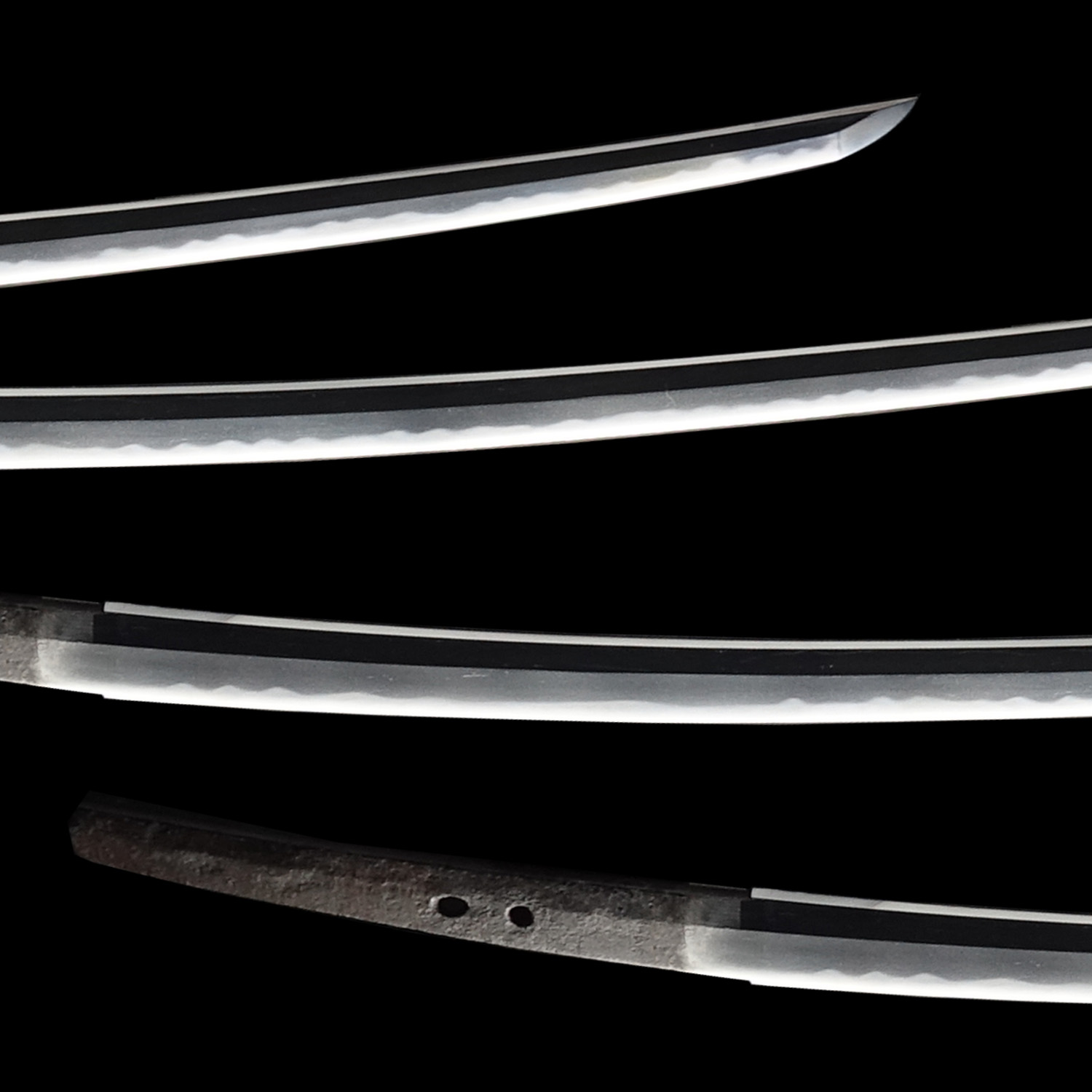
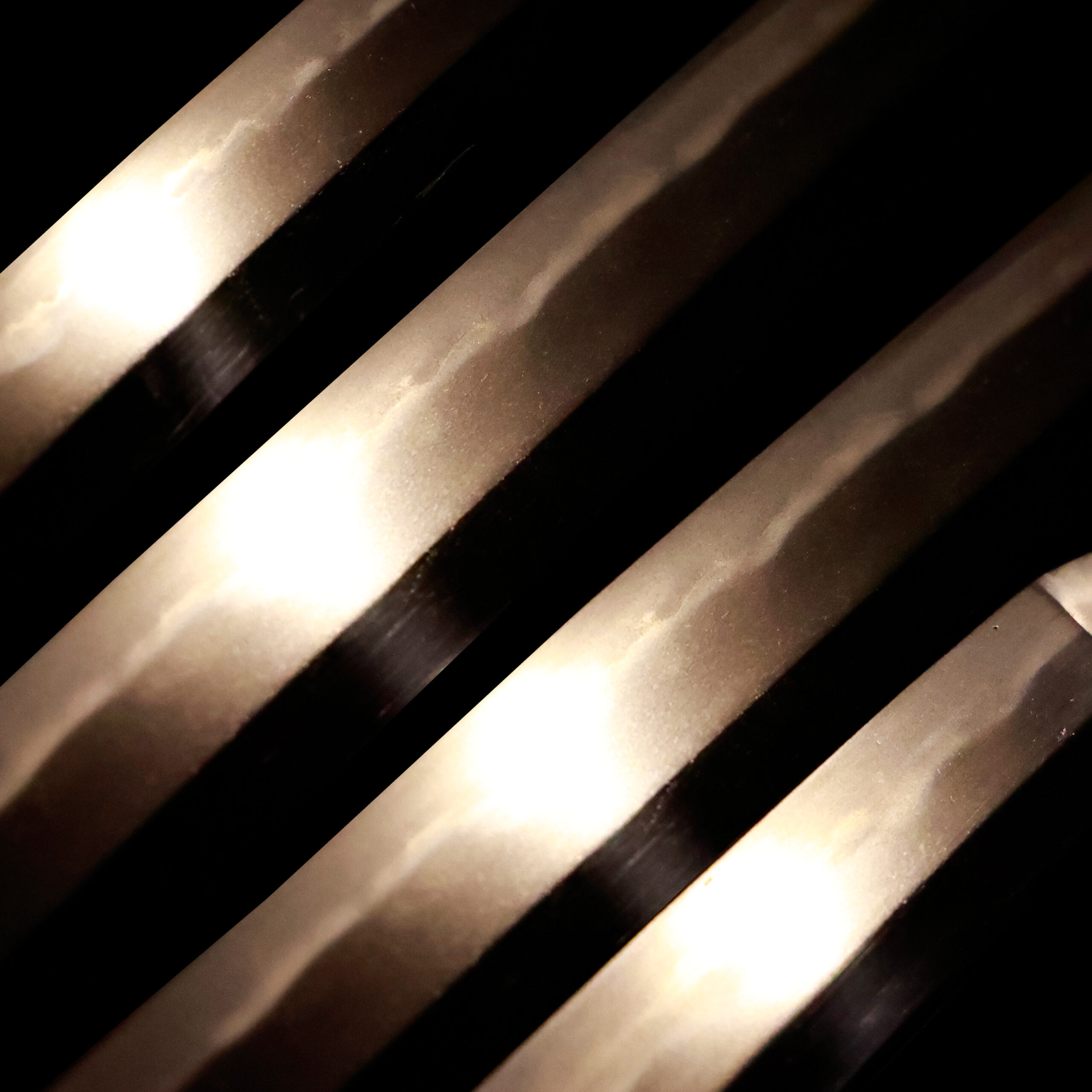
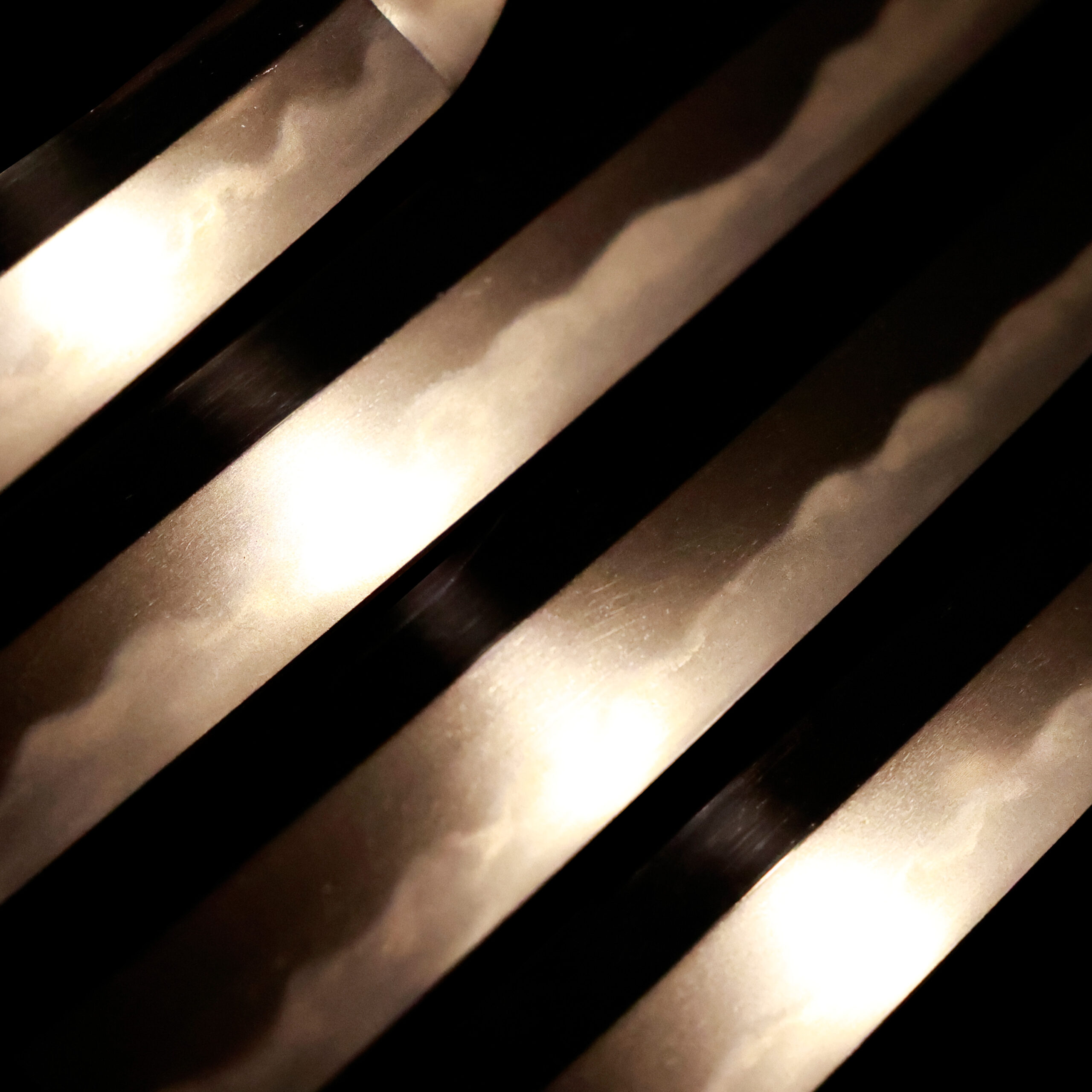

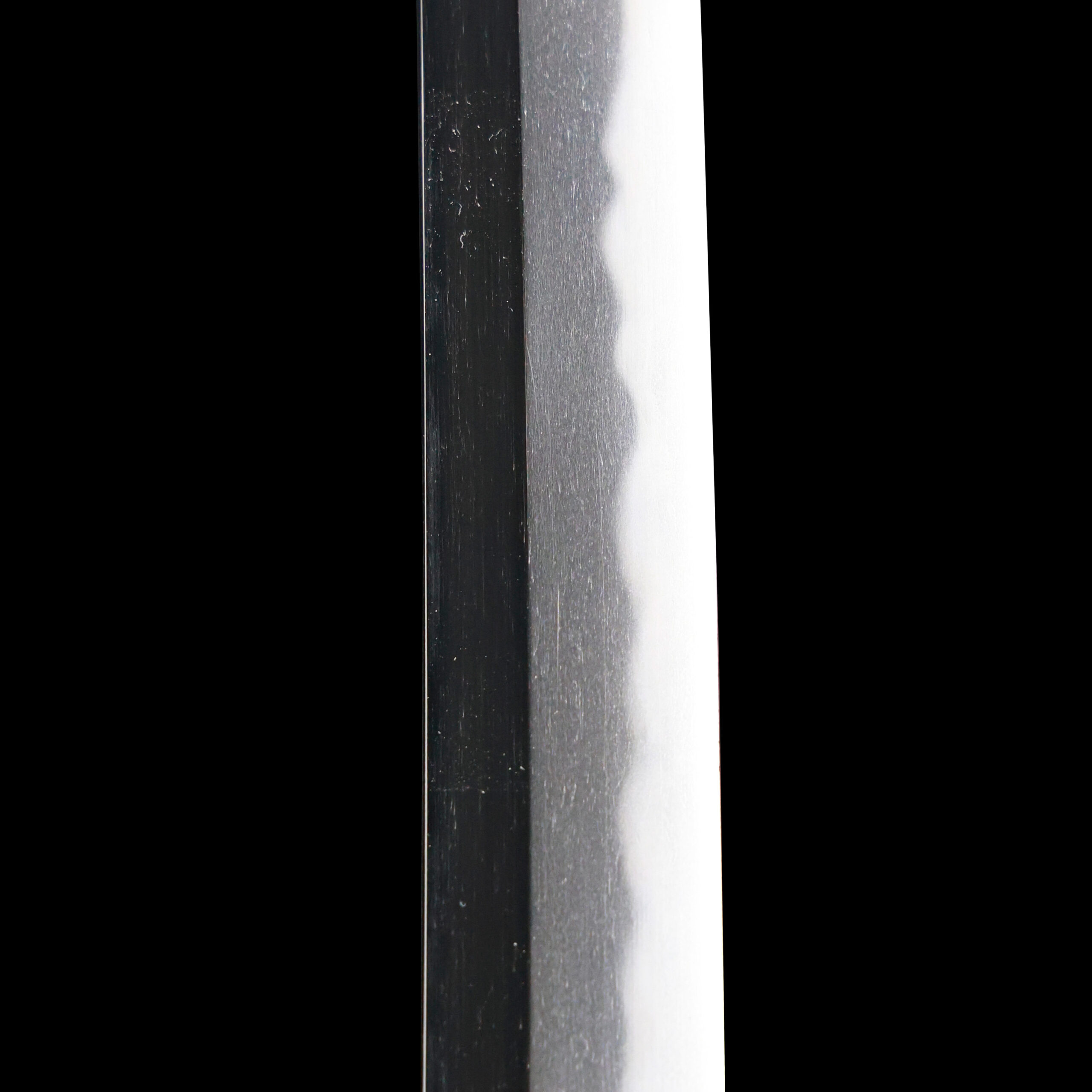
Kissaki:Kissaki is the tip of the Japanese sword.
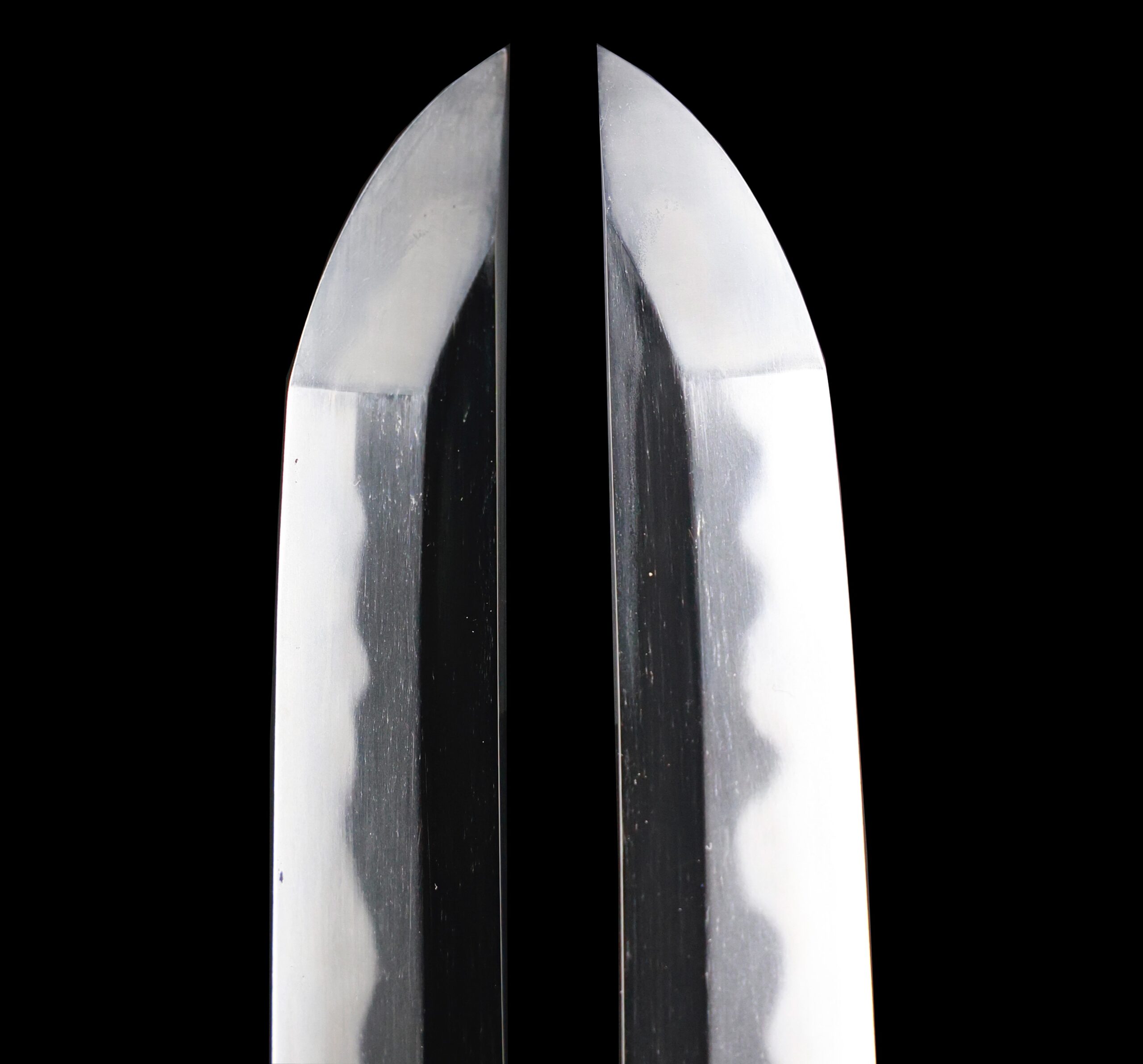
Nakago:Nakago is the tang of the Japanese sword.
Japanese swordsmiths left the black rust on the tang because it prevents red rust while the tang is in its handle. And the discoloration of the tang was created over time, and it is a great indicator for a Japanese sword specialist to estimate when the sword was forged.
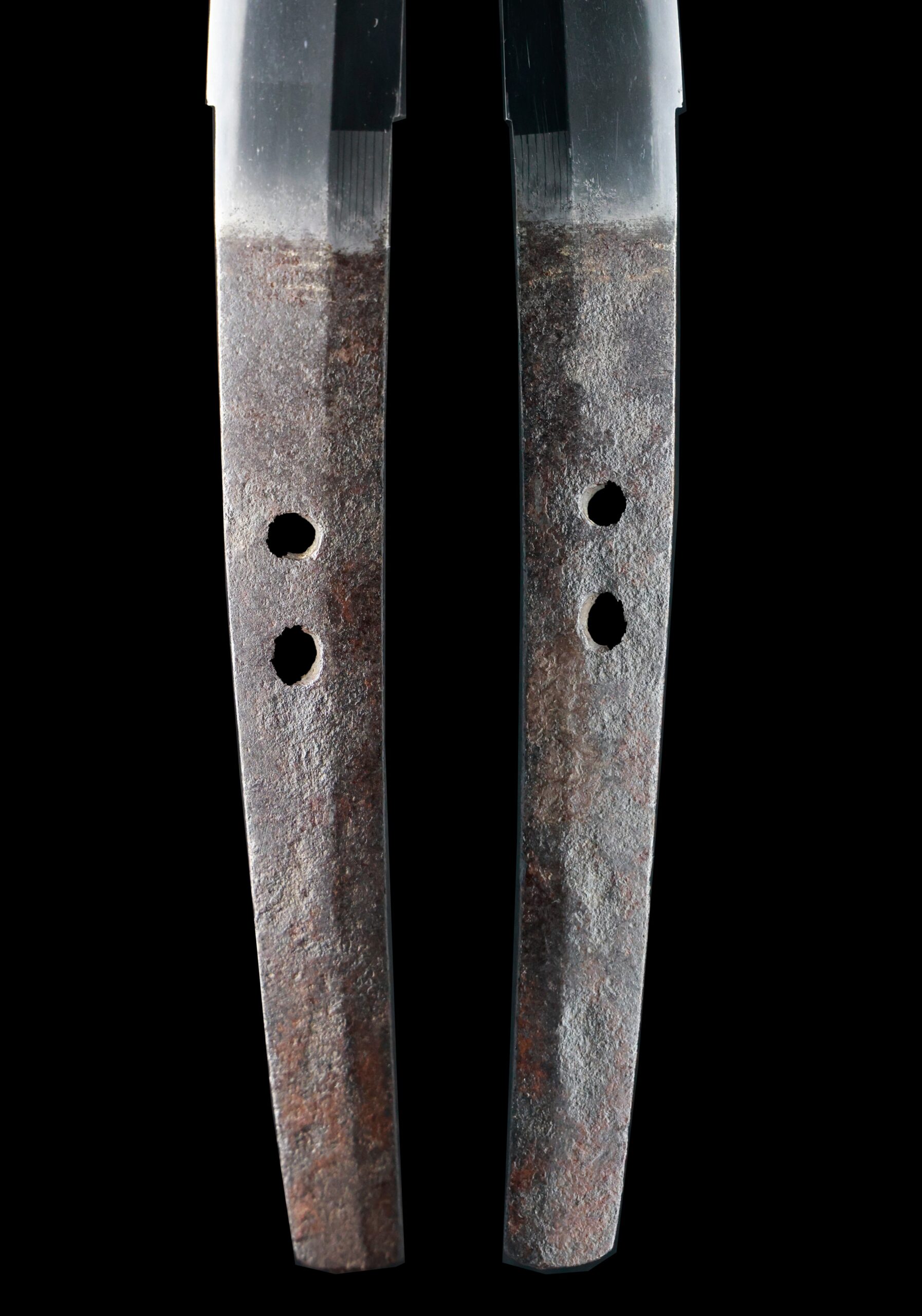
Koshirae:Koshirae is the mounting of the Japanese sword. There are several parts that consist of Koshirae such as Saya (Scabbard), Tsuka (Handle), Tsuba (Handguard).
The overall theme of the sword mounting is Kasakusa (唐草:Arabesque). Arabesque is a pattern in which stems and leaves of vines are twined and make curves. Since ivy has a strong vitality and grows up without interruption, people regarded this design as a symbol of prosperity and longevity. Vine is called Tsuru (蔓) in Japanese, and it has another pronunciation; “Man.” There is a word 万 (it is also read Man), which means ten thousand. In the Karakusa pattern, leaves and vines are connected like Obi (帯, belt). The word “帯” can also be read “Tai.” Due to its pronunciation, the term “代 (Tai)” is associated. From this word-association game, an idiom 万代 is associated, and it means a thousand generations. In other words, we could imagine that people used this design wishing prosperity and longevity for their clans for a long time.

Fuchi-Kashira:A pair of matching sword fittings that cover the upper and bottom parts of its sword hilt.
The Kabutogane (冑金/兜金) is a metal fitting that is attached to the end of a handle. And a Sarute/Sarude (猿手) is attached to this Kabutogane. The user of a sword passed the Udenukio (腕貫緒, a cord wrapped around the wrist to prevent a sword from falling out of the hand, mainly used when riding a horse) through this ring. In addition, the Fuchi Kanamono (縁金物) is also a metal fitting attached to the handle, but on the opposite side of Kabutogane.
Other metal fittings of this Koshirae have the same design such as Kuchi Kanamono (口金物, a metal fitting that is attached to the tip of the scabbard close to Tsuba), Seme Kanamono (責金物, a ring-shaped metal fitting placed in the middle of the scabbard to prevent the sheath from cracking), Ashi Kanamono (足金物, metal fittings attached to the positions where Sageo cord is wrapped), and Ishiduki Kanamono (石突金物, a metal fitting that is attached to the end of the scabbard).
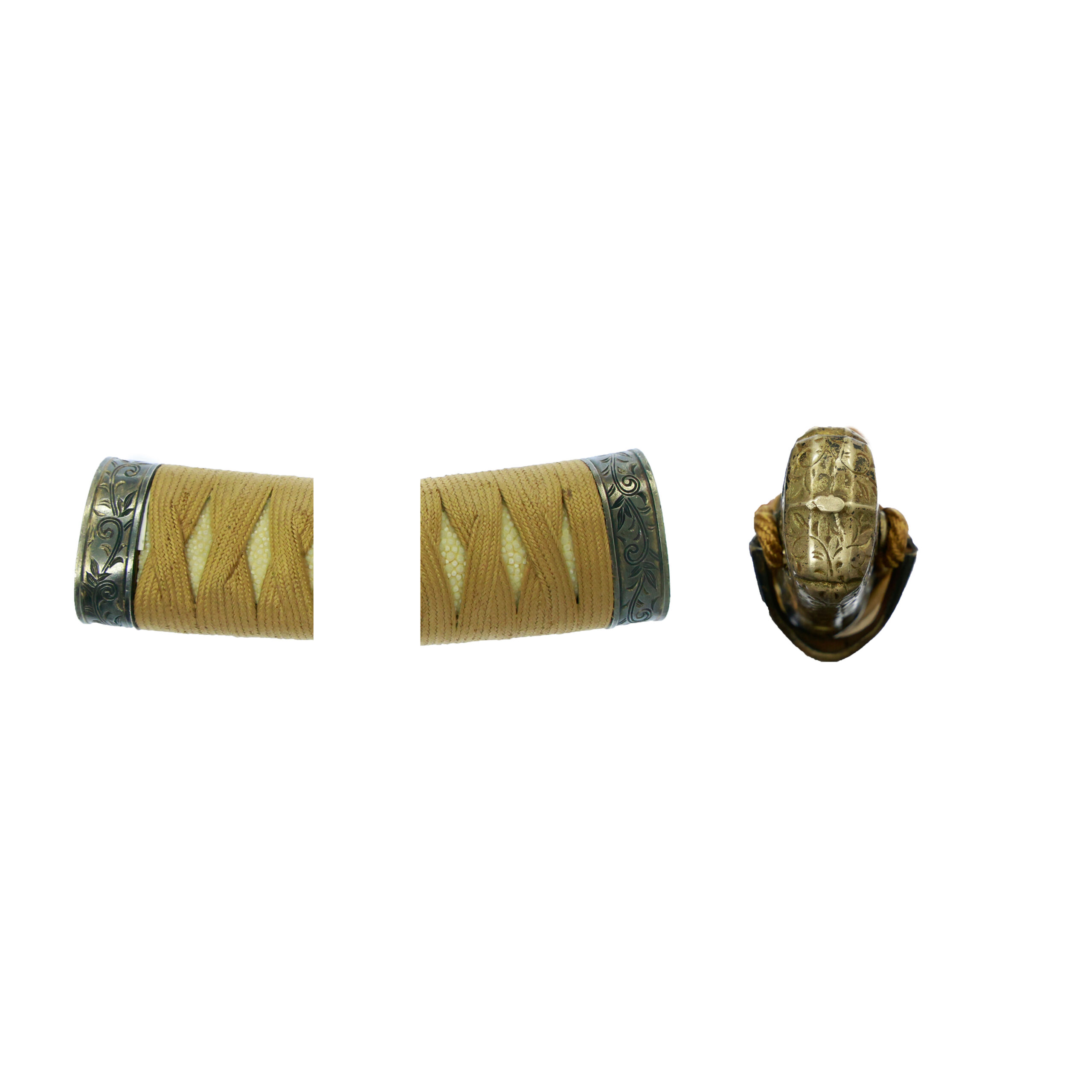
Tsuka and Menuki:Tsuka is the handle of the Japanese sword and Menuki is its decoration.
The motifs of this Menuki seem to be a tiger (虎, Tora). The tiger is a brave animal. A theory says people considered the tiger pattern would protect people from evil spirits. Therefore, its pattern has been treated as a talisman. The tiger design has also been regarded as the symbol of life activity when “tiger” is written by a Japanese Kanji character (漢字, a kind of Japanese letter) based on its meaning. It is said people wished boys’ healthy growth by using the tiger pattern.
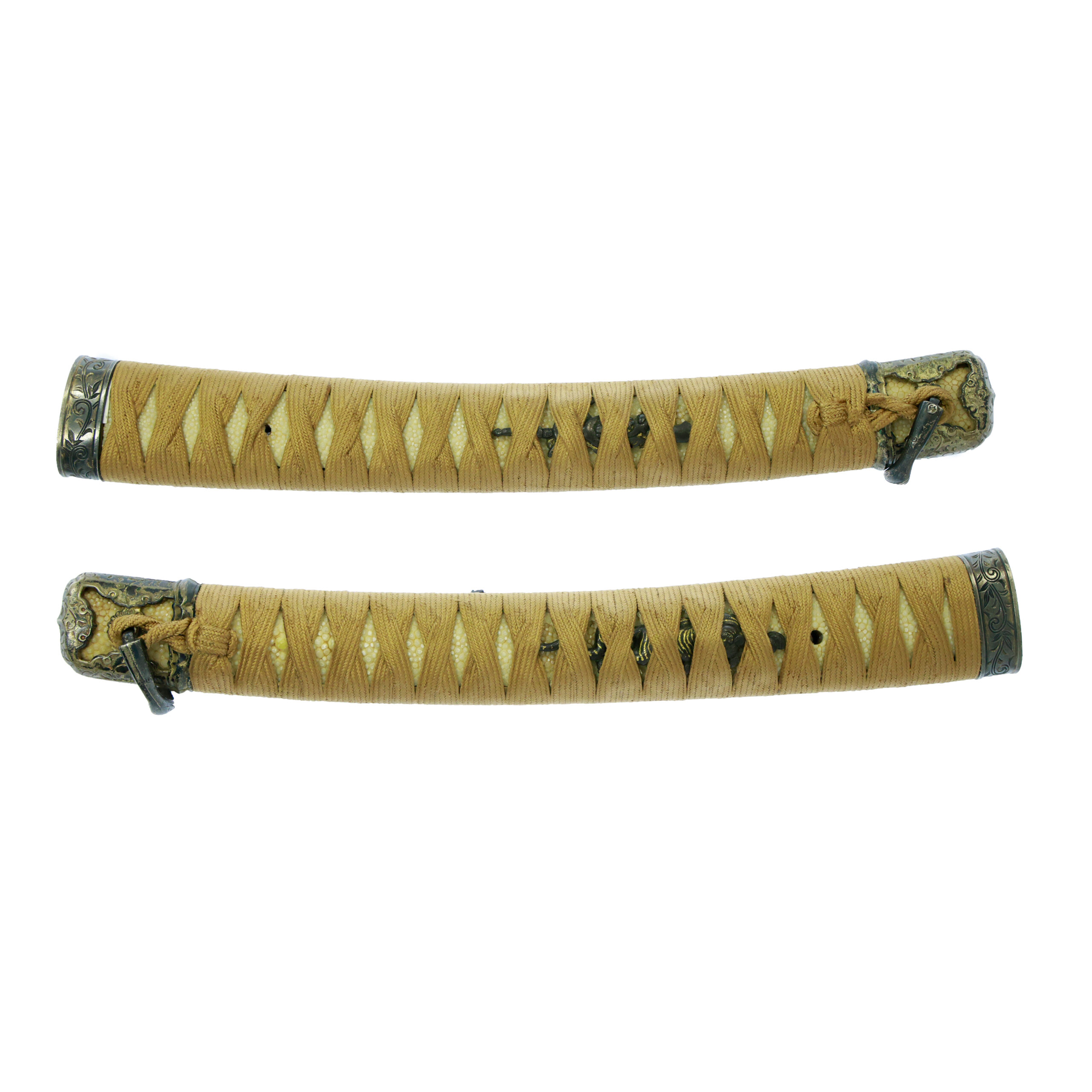

Tsuba and Habaki:Tsuba is the handguard for the Japanese Sword and Habaki is the equipment to make the blade not touch its scabbard inside. It prevents the blade from getting rusty and chipped.
This Tsuba has a Tachi Goshirae Tsuba (太刀拵鐔) style. The difference between Tachi Tsuba (太刀鐔) and Katana Tsuba (刀鐔) is that the top and bottom positions of the Nakago hole (茎櫃, center hole) are reversed. The Tsuba of this Koshirae has Aoi (葵) Tsuba shape. If you focus on four corners, you will find a heart mark-shaped hole is engraved on each edge. It is called the Inome (猪の目) pattern. The Inome pattern has been used since ancient times. As its name implies, the boar’s eyes are the origin of this pattern. Some people believed the Inome design would work as an amulet to protect them from evil spirits or fire. Also, it is said it would bring good luck.
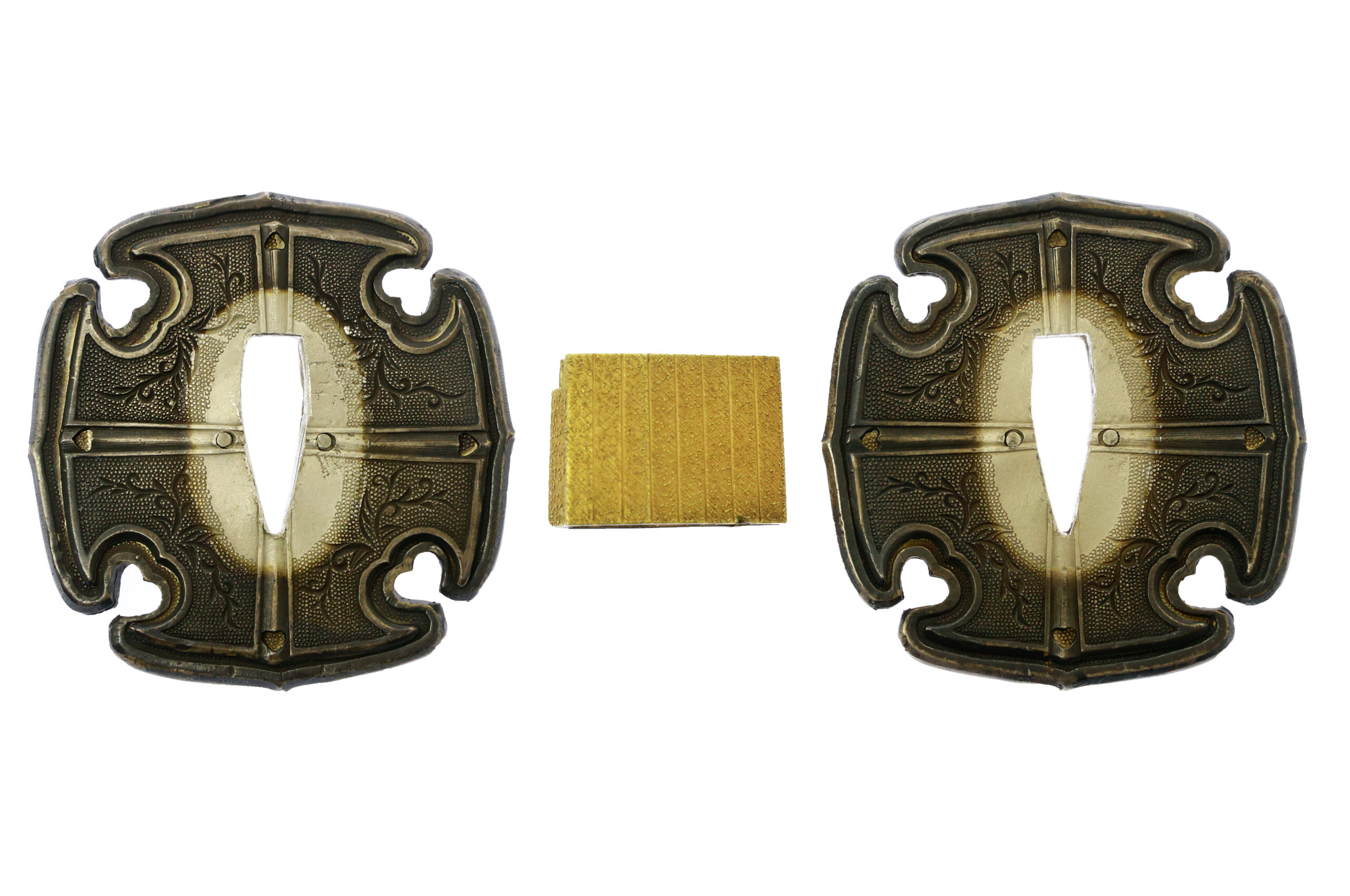
Saya:Saya is the scabbard for the Japanese sword.
The surface of this Saya is decorated with the Nashiji Nuri (梨子地塗/梨地塗) technique, which is a kind of Makie (蒔絵) method. This surface treatment method creates a rough texture by creating fine unevenness on the surface of the metal. They also come in varying degrees of gloss, including glossy, semi-gloss, and matte. According to a theory, it was invented in the Kamakura (鎌倉) period (1185-1333), and in the Edo period, various techniques were devised to color artifacts.
The Seme Kanamono (責金物, a metal fitting attached to the middle of the scabbard to protect the scabbard), the Ishiduki Kanamono (石突金物, a metal fitting attached to the end of the scabbard), these metal parts are also decorated with Karakusa pattern, which is the same as Fuchi Kashira and Tsuba. The Taikogane (太鼓金) is a circle-shaped metal fitting attached to the middle of the Taikogawa (太鼓革). The Taikogawa is made from leather and has a role in fixing the Tachio (太刀緒, Sageo for the Tachi Koshirae).
Agehachou (揚羽蝶, swallowtail) pattern is also designed on this Saya. People preferred the butterfly pattern due to its growth process, beauty, and auspiciousness among the various animal patterns. A larva becomes a chrysalis, and it grows up into a butterfly. As this insect changes its looks, it symbolizes being reborn; therefore, Samurai loved this design. Also, as butterflies make a couple on good terms, this motif represents happy marriage. It is said that the butterfly pattern has been used since the Heian period (794-1185). This design was brought from the continent to Japan, and people introduced it in various fields. As proof of this, butterflies have also appeared in stories, such as the Heike-Monogatari (平家物語, The Tale of the Heike). This insect design gradually began to be used as a family crest, and it spread nationwide by being used by the Taira (平) clan. Taira-no Kiyomori (平 清盛, 1118-1181), who was the leader of the Taira family, used the Agehachou crest. That is, it was treated as a symbolic design of the Heike (平家). According to a theory, about 300 Samurai used this motif for their family crests in the Edo period. It tells us the close relationship between the butterfly pattern and Samurai culture.
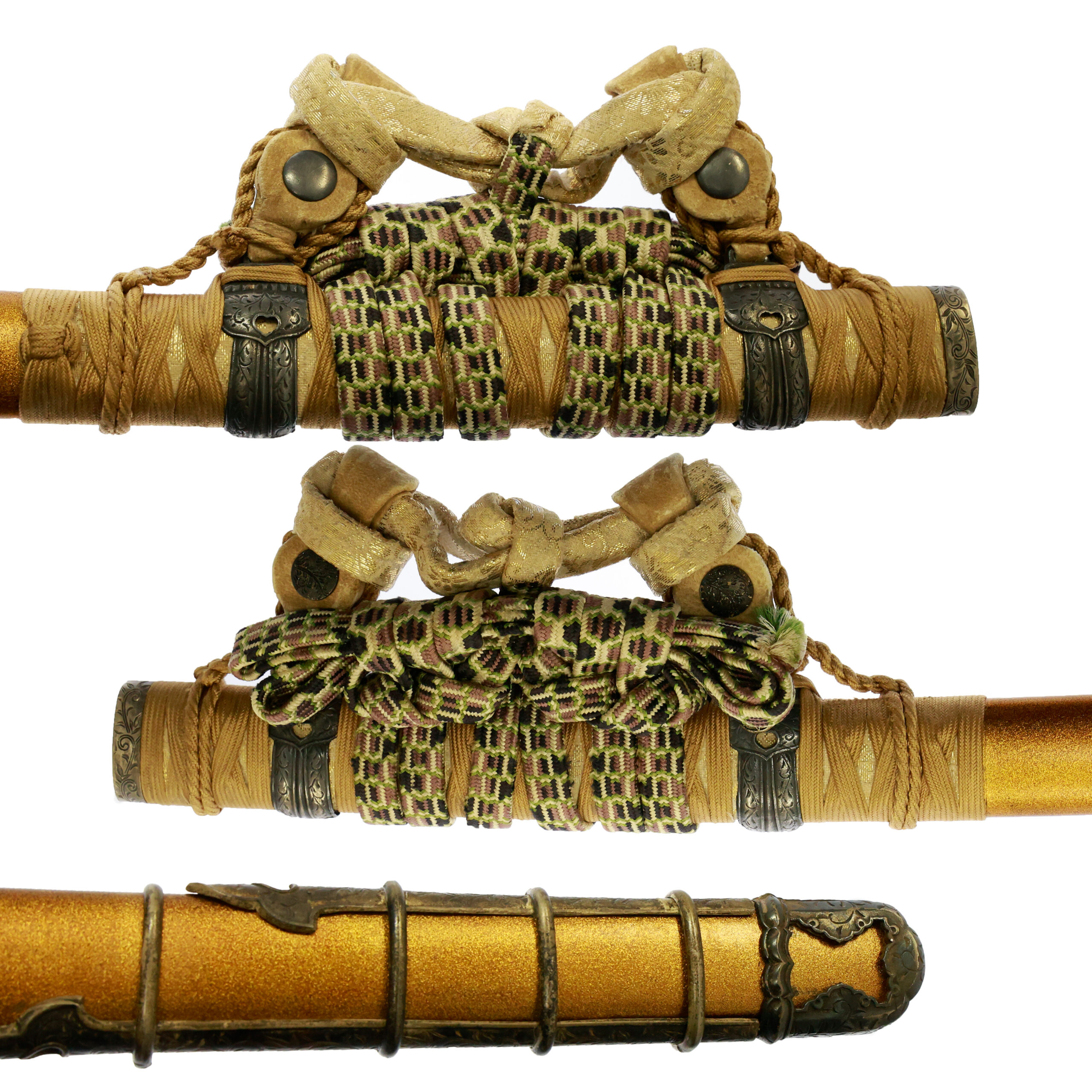
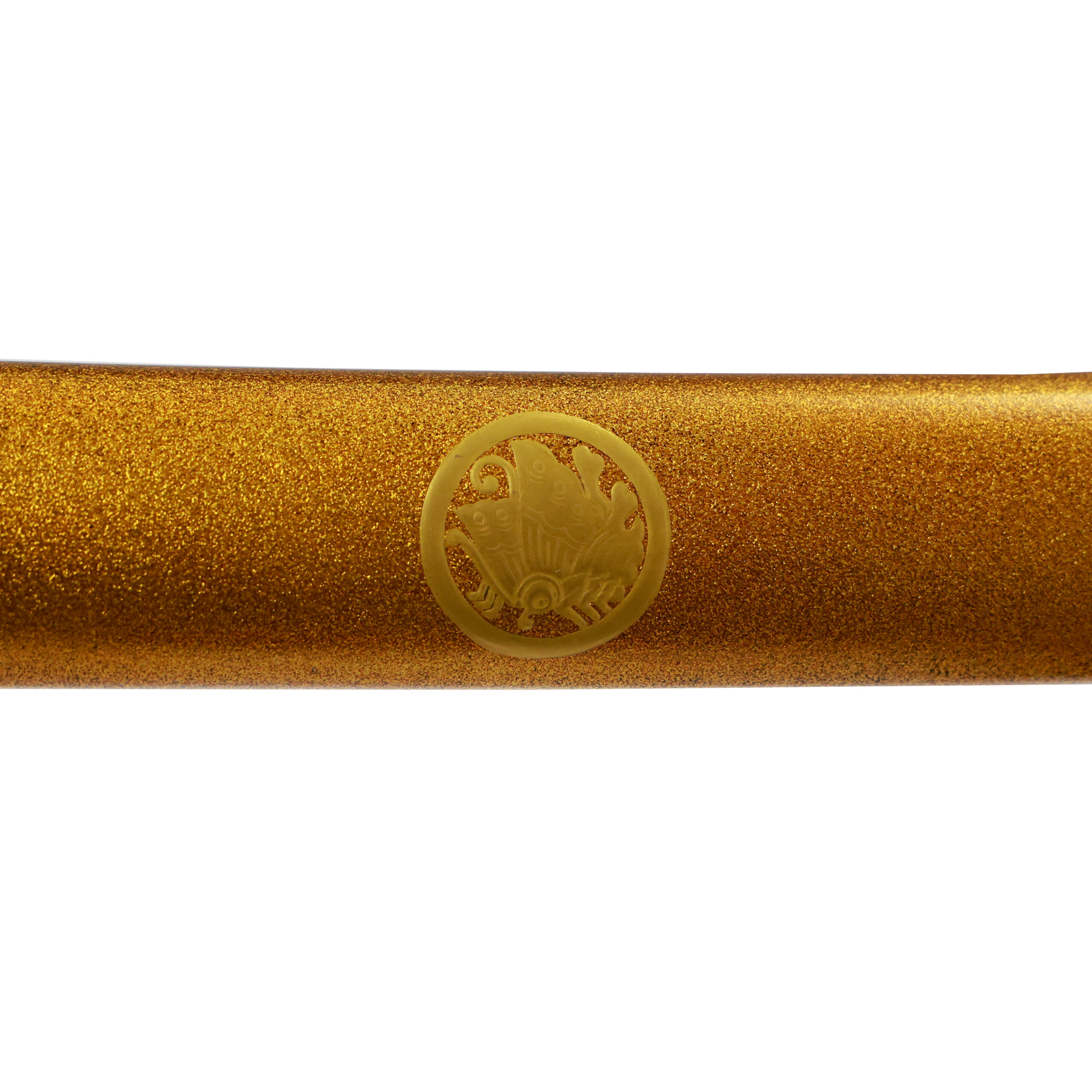
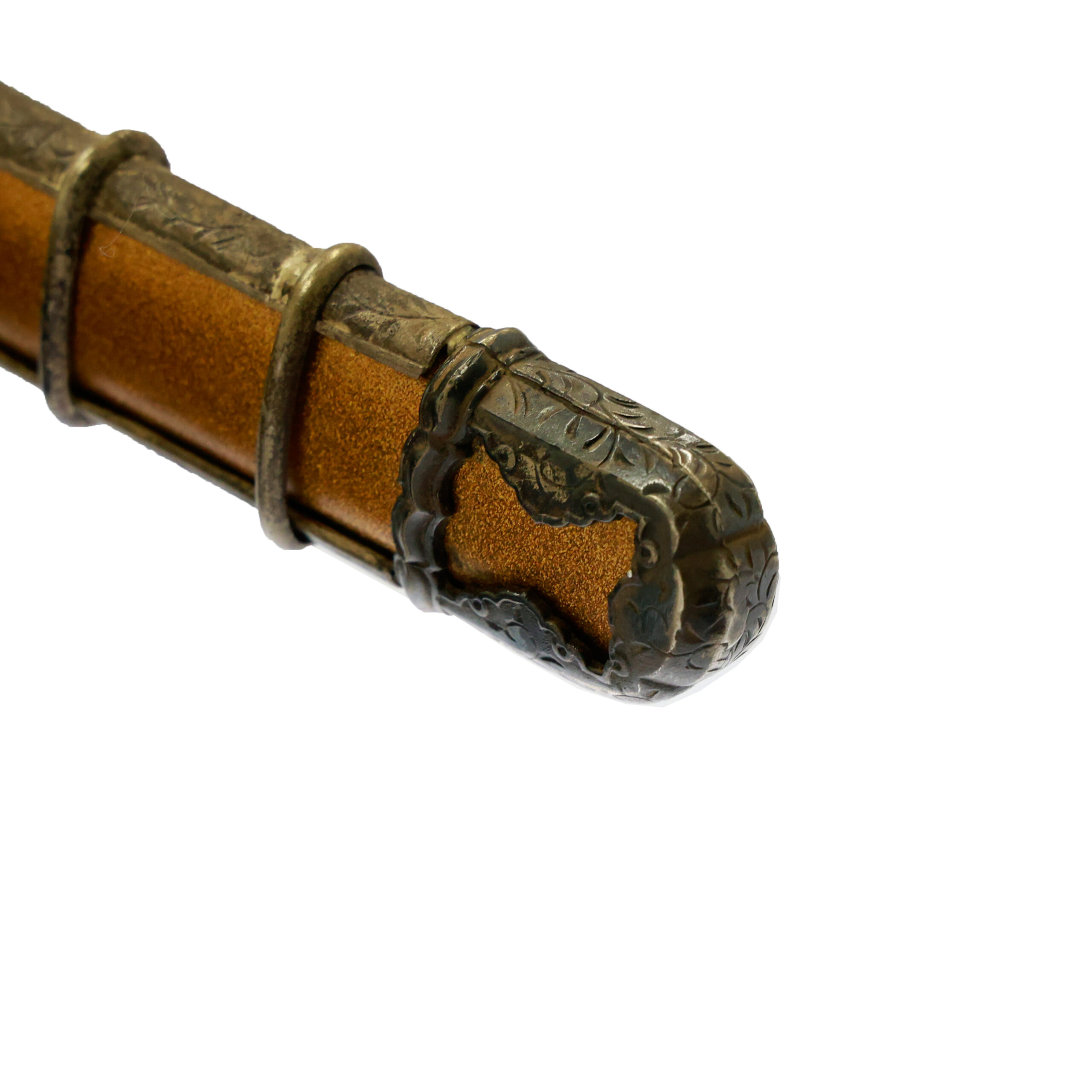
Authentication Paper:NBTHK TOKUBETSU Hozon Certificate for the blade (No. 1020417)
NBTHK, also known as Nihon Bijutsu Touken Hozon Kyokai (the Society for the Preservation of the Japan Art Sword), is one of the oldest Japanese sword appraising organizations in modern-day Japan. They authenticated the blade on May 31th in the 5th year of Reiwa (2023). They appraised it as Tokubetsu Hozon Touken, the blade especially worth preserving for Japanese society. The purchaser will receive this original certificate as well. We can also translate what is written into English and make a PDF file for your record if you request.
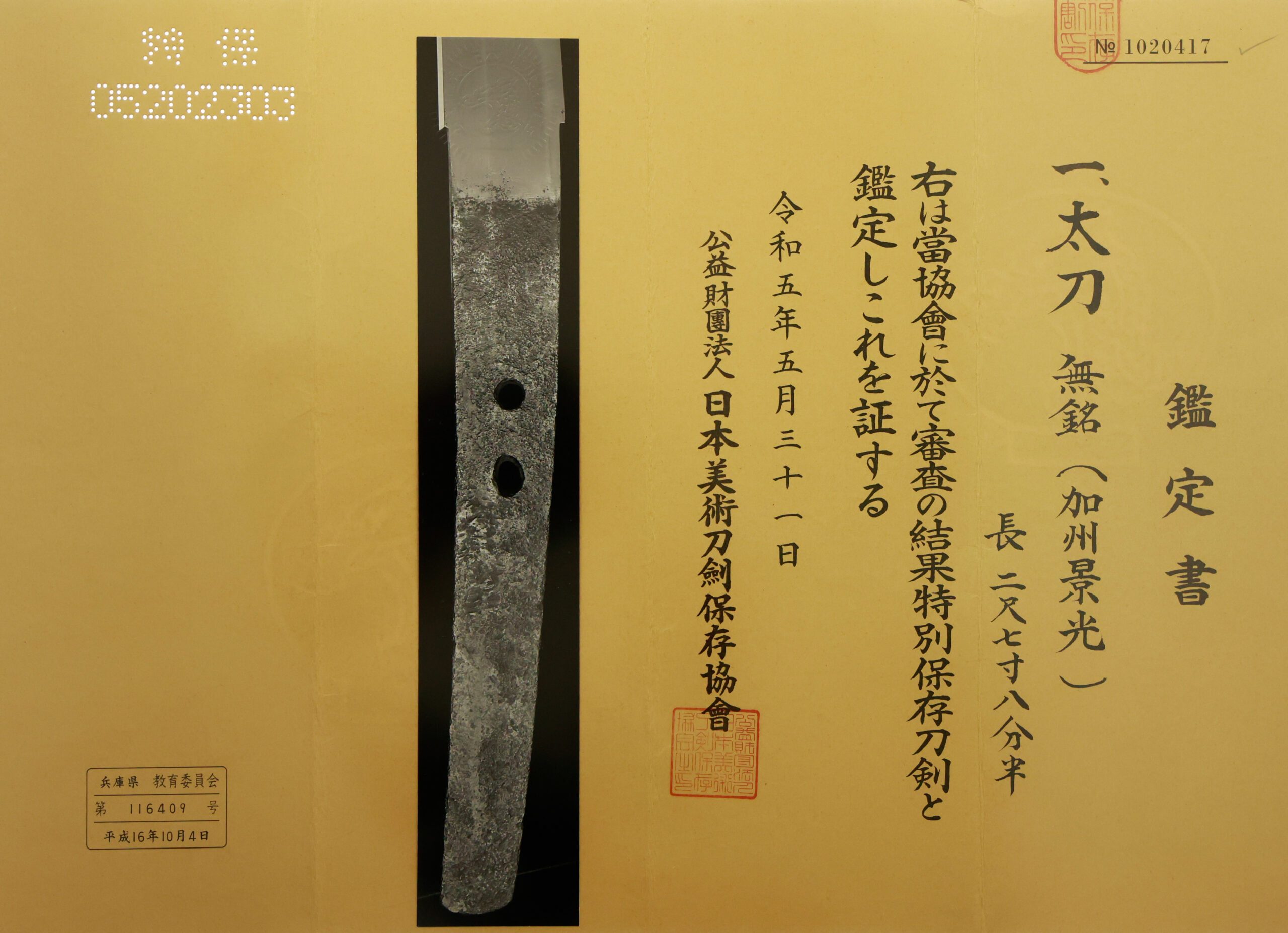
Registration Number : Hyogo 116409
The Board of Education in Hyogo prefecture issued a registration paper for this sword. It is called Jyu Hou Token Rui Tourokusho (銃砲刀剣類登録証). Bunkacho (The Agency for Cultural Affairs) acknowledges a Japanese sword with this paper as a work of art.
The sword needs to be traditionally hand-forged and made of Tamahagane carbon steel to be registered in the system. With this paper, its owner in Japan can legally own an authentic Japanese sword. Based on this registration number, we will apply for its export permit.
This paper will need to be returned to the board of education when the sword is being shipped abroad, but you can receive a copy of it. An English translation of this registration paper is available on request.

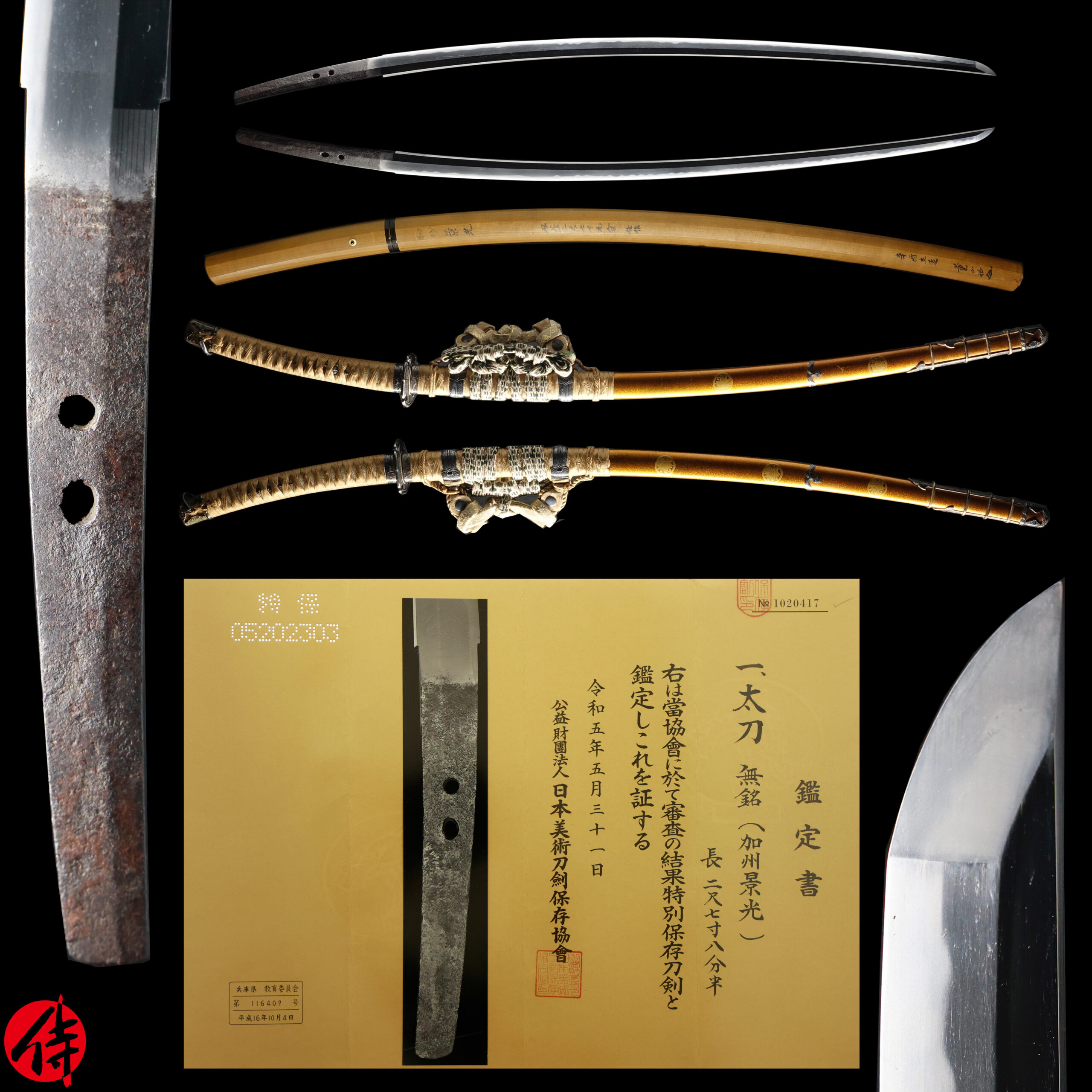
—————————————————————–
【About us】
Samurai Museum is located in Tokyo, Japan, exhibiting antique artifacts related to the Samurai history. Samurai Museum Shop is the place for those who are interested in Japanese culture and craftsmanship. We deal with antique Samurai swords/armor, traditional crafts made in Japan and so on.
【Japanese Sword& Export Process】
The Japanese swords we deal with are hand-forged edged swords made in Japan. It was made from the traditional carbon steel called TAMAHAGANE(玉鋼). Samurai Museum is familiar with the proper legal procedure for an antique/ authentic Japanese sword to be exported from Japan. We have sent more than 700 Japanese swords for the past few years (~2024) to amazing owners who appreciate its historical value.
Each Japanese sword is registered under the Agency for Cultural Affairs and the Board of Education in Japan. They issue a registration paper for each Japanese sword for its owner in Japan to legally possess it. The Japanese sword with its registration paper means it was traditionally hand-forged in Japan.
To legally export the sword from Japan to other countries, we will have to apply for its permit to the Agency for Cultural Affairs(Bunkacho) and return the original registration paper to the Board of Education. It normally takes around 2-4 weeks to receive this permit after submitting required documents. And we would like you to expect at least 1-1.5 months for your order to arrive at your given address after you ordered. For more detailed info, please click here.
It is allowed for residents in Japan to own authentic Japanese swords without a special license as long as they come with registration papers. Please feel free to contact us if you are a resident of Japan, whether temporarily or permanently. We will also assist you when you leave Japan and need to obtain the export permit.
【Payment Method】
We accept payment through Stripe (Credit card), PayPal, Apple Pay or ChromePay, all of which are secure payment methods. Also, you don’t need to make an account on Stripe for the checkout. If you prefer other payment method, please contact us. After confirming your payment, we will apply for an export permit. You may either pay in JPY, USD, AUD, CAD,EUR CHF or GBP. The price is set in Japanese Yen. Prices in other currencies are automatically calculated based on the latest exchange rate.

* If the amount is above 1 million JPY, Stripe or wire transfer will be the only options for payment.
【Shipping】
We have shipped authentic Japanese swords to the USA, Canada, Mexico, Germany , Belgium, France, Finland, UK, Hong Kong, Australia. If you don’t live in these countries and like to order, please contact us first before making a purchase. We offer Free International Shipping as long as we can send antique Japanese swords by EMS.
We normally ship by EMS(Express Mail Service) provided by Japan Post. We will send you a tracking number for your order as soon as we hand it to the post office. We will put 100 % insurance on the shipping document without any extra charge. Based on the total amount, there might be a duty tax or other fee for you to pay, depending on the countries. We use package cushioning to protect the item and put it in a PVC pipe, which is one of the most secure packages because of its durability.
It will normally takes 5-14 days for the item to arrive at your given address after we dispatch it. Time of delivery is estimated as accurately as possible by the carrier but does not take into account any delays beyond our control such as by inclement weather, post office holiday seasons.
* If you live in Australia and like to purchase an authentic Japanese sword, please click here to know the detail.
* If you live in the UK and like to purchase an authentic Japanese sword, please contact us first and click here to know the detail.

【Review】
Here is one of the reviews we received from a customer who purchased an authentic Japanese sword from us. For more reviews, please click here.
“My experience overall with the whole process was wonderful. I had many questions about the history and process to purchase these treasures. All my questions were answered very timely and complete. The staff is very knowledgeable and very well versed if any questions do arise.”
【How to make sure the condition】
Please keep in mind that what you are going to purchase is an antique item. We uploaded high resolution photos for you to check its condition thoroughly. If you like to see more photos with different angles, please feel free to contact us. We will be happy to send them to you so that you can make informed decision. It is essential for us to know that you are happy with your choice of a sword. and we are prepared to use the best of our ability to serve you.
【How To Contact Us】
Please contact us through email, Facebook Messenger or Live Chat if you have any questions. You can find each icon on the right side of the website. Please click one of them to reach us. We will reply to you within 1-2 business days.
【The Art of Nihonto (Japanese Sword)】
Samurai’s history is a profound, eloquent legacy of ancient Japanese warriors in which millions of people worldwide are being fascinated. If you like to find out the art of Nihonto, please click here.
【A Guide to Japanese Sword Maintenance】
After acquiring an genuine Japanese sword, it is also important to know how to take good care of it. Here is the special video for you. Mr. Paul Martin, Japanese sword expert, shows you how to give proper maintenance to your sword. By mastering how to clean the Japanese sword, its aesthetic beauty will last forever.
When you purchase a Japanese sword from us, you can get a Free Japanese sword maintenance kit. It comes with four tools(Choji Oil, Uchiko Whetstone Powder, Peg remover, Oil Applicator). By watching the video instruction above , you can enjoy learning how to maintain your Japanese sword while appreciating it. If you have any difficulty assembling the sword or cleaning the blade, you can feel free to contact us.
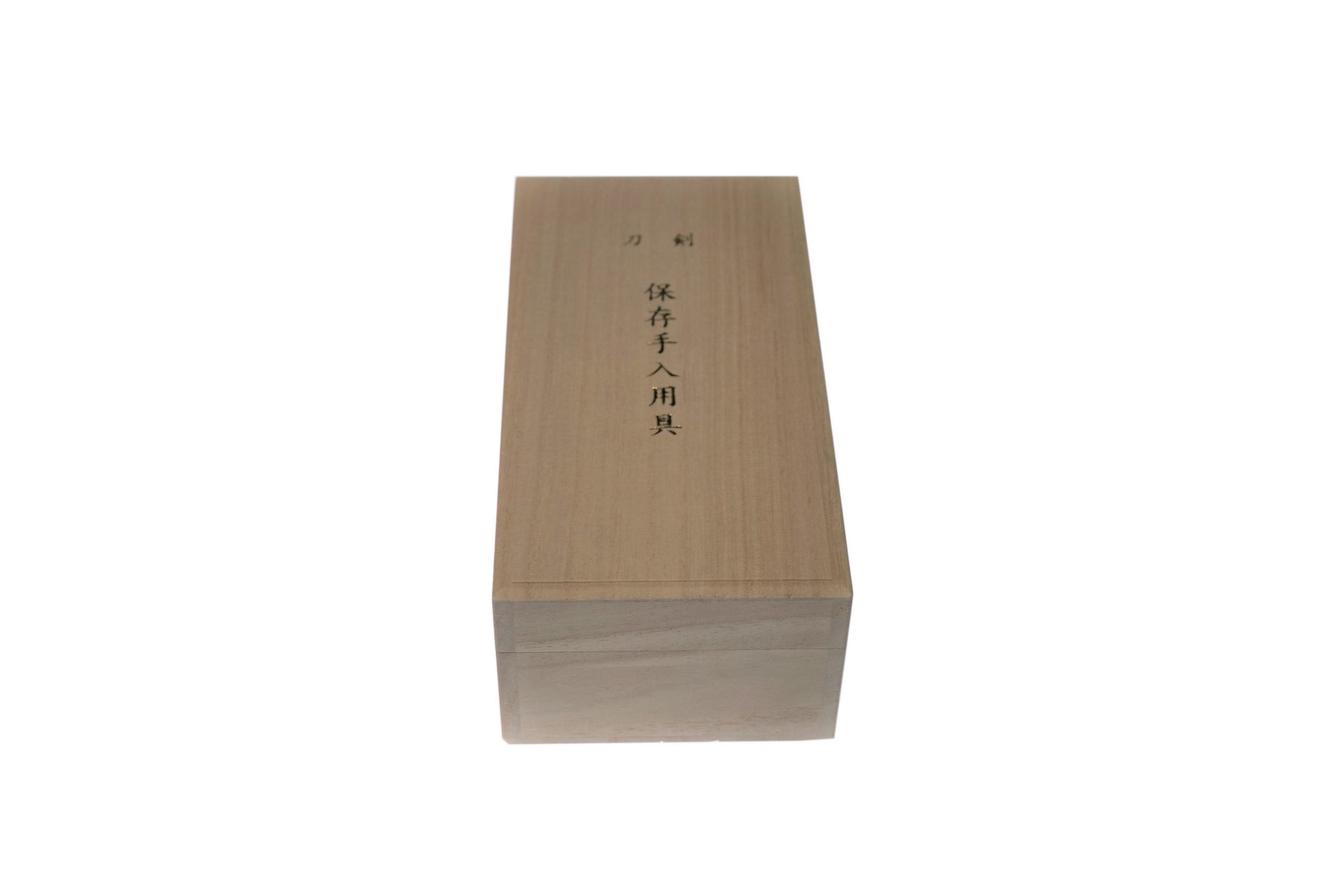
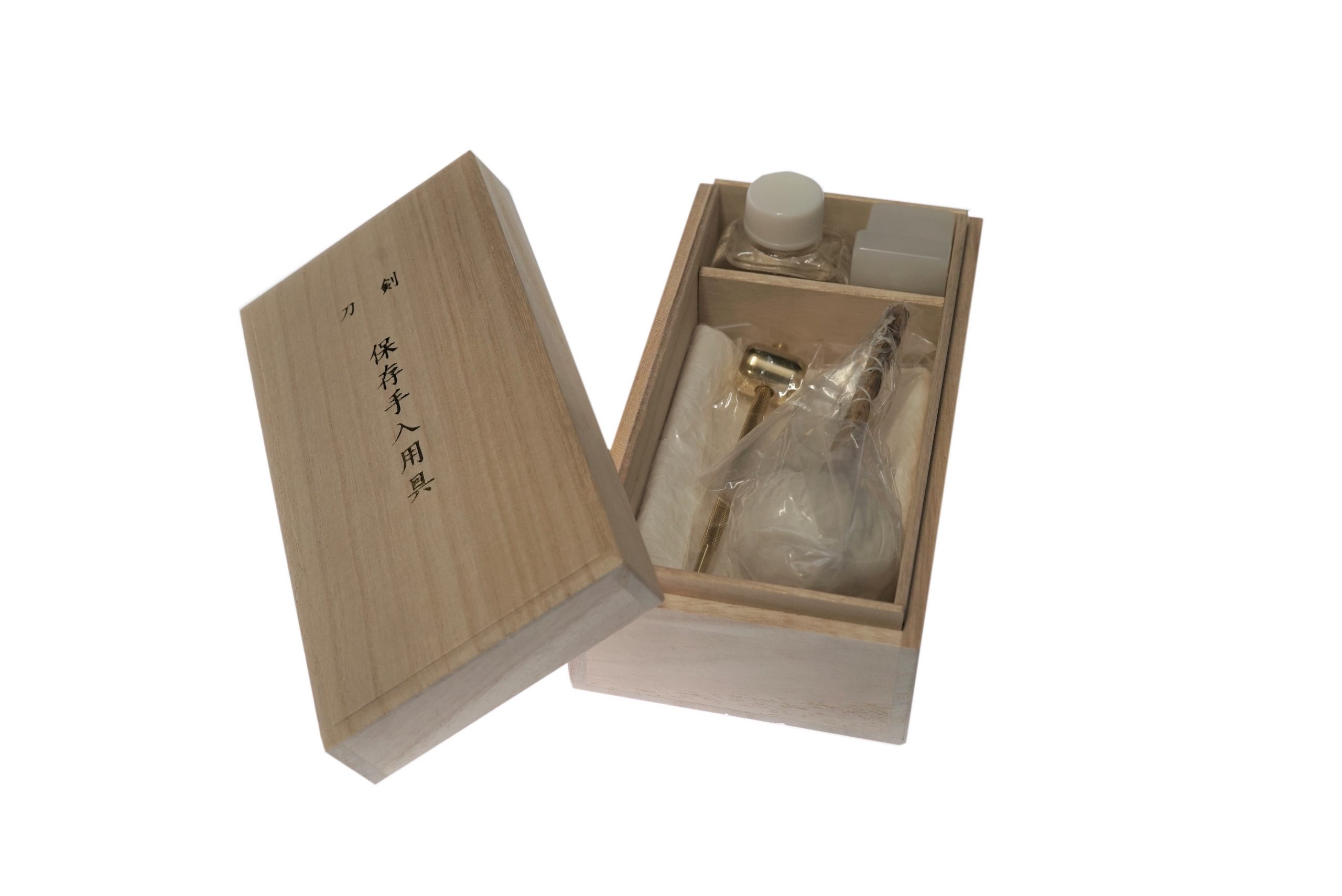
MORE ANTIQUE JAPANESE SWORD FOR SALE
SWORDS WITHOUT CERTIFICATES FOR SALE
LEARN JAPANESE SWORD TERMINOLOGY
Thank you for reading all the information on the page. If you have any difficulty choosing the right Japanese sword for you, we will be more than happy to help you find the one that speaks to you the most. Please feel free to contact us.


